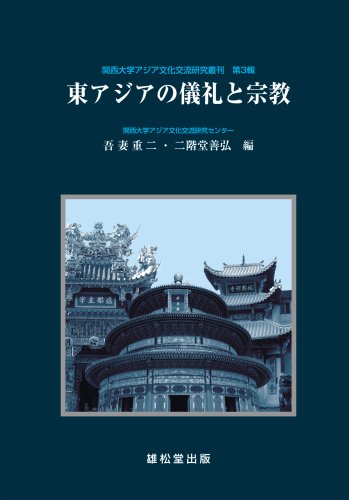7 0 0 0 OA 浙江・江蘇地域の道教・民俗信仰に関する廟宇・祭神・儀礼調査
2 0 0 0 OA 関西大学東西学術研究所鱒澤文庫目録(初稿)
2 0 0 0 OA 東アジアにおける伝統教養の形成と展開に関する学際的研究:書院・私塾教育を中心に
- 著者
- 吾妻 重二 三浦 國雄 陶 徳民 湯浅 邦弘 二階堂 善弘 藤田 高夫 澤井 啓一 井澤 耕一 藪田 貫 原田 正俊 増田 周子 篠原 啓方 西村 昌也 于 臣
- 出版者
- 関西大学
- 雑誌
- 基盤研究(A)
- 巻号頁・発行日
- 2009
東アジア地域、すなわち中国、韓国・朝鮮、ベトナム、日本など「漢字文化圏」といわれる諸地域における伝統教養の形成と展開を、書院・私塾における教育と講学機能を通して学際的に考察し、多くの論文、図書を公刊した。他の個別作業としては、朱熹の書院講学の記録『朱子語類』の訳注を作成し、さらに大阪の漢学塾「泊園書院」およびその蔵書「泊園文庫」を調査して『泊園書院歴史資料集』や『泊園文庫印譜集』などを公刊するとともに、充実したコンテンツをもつ「WEB 泊園書院」を公開した。
1 0 0 0 OA 『大乗起信論義記』研究(二)
- 著者
- 吾妻 重二 井上 克人 丹治 昭義
- 出版者
- 関西大学東西学術研究所
- 雑誌
- 関西大学東西学術研究所紀要 (ISSN:02878151)
- 巻号頁・発行日
- vol.33, pp.1-26, 2000-03-31
神秘主義研究班
1 0 0 0 OA 『大乗起信論義記』研究(四)
- 著者
- 吾妻 重二 井上 克人 丹治 昭義
- 出版者
- 関西大学東西学術研究所
- 雑誌
- 関西大学東西学術研究所紀要 (ISSN:02878151)
- 巻号頁・発行日
- vol.36, pp.115-132, 2003-03-31
神秘主義研究班
1 0 0 0 OA 『大乗起信論義記』研究(三)
- 著者
- 吾妻 重二 井上 克人 丹治 昭義
- 出版者
- 関西大学東西学術研究所
- 雑誌
- 関西大学東西学術研究所紀要 (ISSN:02878151)
- 巻号頁・発行日
- vol.34, pp.63-79, 2001-03-31
神秘主義研究班
1 0 0 0 OA 『大乗起信論義記』研究
- 著者
- 井上 克人 薗田 香融 川﨑 幸夫 丹治 昭義 吾妻 重二 木村 宣彰
- 出版者
- 関西大学東西学術研究所
- 雑誌
- 関西大学東西学術研究所紀要 (ISSN:02878151)
- 巻号頁・発行日
- vol.31, pp.51-77, 1998-03-31
神秘主義研究班
1 0 0 0 OA 『大乗起信論義記』研究(五)
- 著者
- 吾妻 重二 井上 克人 丹治 昭義
- 出版者
- 関西大学東西学術研究所
- 雑誌
- 関西大学東西学術研究所紀要 (ISSN:02878151)
- 巻号頁・発行日
- vol.38, pp.31-52, 2005-04-01
1 0 0 0 OA 『続修四庫全書』と四庫関連叢書
- 著者
- 吾妻 重二
- 出版者
- 関西大学図書館
- 雑誌
- 関西大学図書館フォーラム = Kansai University Library forum (ISSN:13420828)
- 巻号頁・発行日
- vol.9, pp.18-22, 2004-06-30
虫ぼし抄
1 0 0 0 東アジアの儀礼と宗教
- 著者
- 吾妻重二 二階堂善弘編
- 出版者
- 雄松堂出版
- 巻号頁・発行日
- 2008
- 著者
- 吾妻 重二
- 出版者
- 関西大学文化交渉学教育研究拠点(ICIS)
- 雑誌
- 東アジア文化交渉研究 = Journal of East Asian Cultural Interaction Studies (ISSN:18827748)
- 巻号頁・発行日
- vol.2, pp.47-66, 2009-03-31
In this paper, education and Gaku Juku of the key persons who dictated the acceptance of Neo-Confucianism in the early Edo period, such as Seika Fujiwara, Sekigo Matsunaga, Kyoan Hori, Razan Hayashi, and Gaho Hayashi, are discussed. Needless to say, it is due to acquired education that wisdom and thoughts are transferred and reproduced and "cultures" are formed. I'd like to consider how they viewed Confucian cultures in China and Korea and how those Confucian cultures were accepted in Japan, especially taking influences from and comparisons between China and Korea. The establishment of Byo-gaku system by Razan Hayashi and development of Gaku Juku organizations and educational rules by Gaho Hayashi are revaluated while the development of their visions of Gaku Juku is traced from the viewpoint of cultural interaction.
1 0 0 0 IR 水戸藩の儒教喪祭儀礼文献について
- 著者
- 吾妻 重二
- 出版者
- 関西大学東西学術研究所
- 雑誌
- 関西大学東西学術研究所紀要 (ISSN:02878151)
- 巻号頁・発行日
- no.48, pp.31-52, 2015-04
Among the most important daimyo of early modern Japan to embrace and promulgate Confucianism were Tokugawa Mitsukuni of Mito and Ikeda Mitsumasa of Okayama, and both were naturally keenly interested in Confucian ritual practices. Confucianism particularly flourished in Mito during Mitsukuni's era and later, at the end of the Tokugawa period, when Tokugawa Nariaki was daimyo of the domain. But throughout this period, Mito Confucianists conducted an earnest inquiry into the proper procedure for the conduct of funeral and ancestral rites, in which Zhu Xi's Jiali (Family Rituals) functioned as a key text. This paper will trace the development of Confucian ritual practice in Mito, accompanied by a broad examination of the textual sources related to funeral and ancestral rituals. In addition, although some scholars have argued that funeral rites in Mito were conducted in a Shinto style, this paper provides evidence that this is a misinterpretation and that Mito funerary rites were fundamentally Confucian in nature.
1 0 0 0 OA 池田光政と儒教喪祭儀礼
- 著者
- 吾妻 重二
- 出版者
- 関西大学文化交渉学教育研究拠点(ICIS)
- 雑誌
- 東アジア文化交渉研究 = Journal of East Asian Cultural Interaction Studies (ISSN:18827748)
- 巻号頁・発行日
- vol.1, pp.79-104, 2008-03-31
This paper adds consideration to the issue of the burial systems, funeral services, the erecting of family mausoleums, and ancestral rituals, etc., that are based on the practice of Confucian rituals – especially those related to funerals and festivals – by Mitsumasa Ikeda (1609‒1682) in Bizen Okayama clan. The funeral and ancestral rituals that Ikeda implemented were based on Zhu Xi’s Family Rituals (家礼), they also referenced Qiu Jun’s Wengong Jiali Yijie (文公家礼儀節) and adopted Jigu Dingzhi (稽古定制), both Ming Dynasty writings, in order to suit his position as a daimyo (大名) feudal lord. Attention is also brought to the fact that when the shinshoku-uke (神職請) Shinto priest system was implemented in place of the tera-uke (寺請) temple certifi cate system due to the strong critique on Buddhism at the time, Ikeda distributed a funeral and ancestral manual based on Family Rituals to the people of his fi efdom and promoted Confucian rituals. What is also important here when taking into account the actual circumstances of the acceptance of Confucian rituals in Japan is the fact that the Yangming School, including Kumazawa Banzan, supported these resolute actions by Ikeda, emphasized the necessity for practice of Family Rituals, so the differences between the study of Zhu Xi’s writings and the ideas of the Yangming School sects did not become an issue.
1 0 0 0 IR 「続修四庫全書と四庫関連叢書
- 著者
- 吾妻 重二
- 出版者
- 関西大学
- 雑誌
- 関西大学図書館フォーラム (ISSN:13420828)
- 巻号頁・発行日
- vol.9, pp.18-22, 2004
虫ぼし抄
1 0 0 0 斎〓の研究
研究代表者の小林正美は平成16年3月に調査した四川省綿陽・安岳・大足の摩崖道教造像に関する論文「金〓斎法に基づく道教造像の形成と展開-四川省綿陽・安岳・大足の摩崖道教造像を中心に」を作成し、さらに12月に四川省仁寿県牛角寨壇神岩の摩崖道教造像の調査を行い、論文の内容を補強した。また、小林は道教の斎法の原型である指教斎法の成立と構造に関する論文「道教の斎法儀礼の原型の形成-指教斎法の成立と構造」を作成した。本年度は研究期間の最終年度にあたるので、研究分担者はそれぞれ以下の報告論文を作成した。森由利亜 「清朝全真教と天師道儀礼の関係に関する覚え書き」吾妻重二 「宋代の景霊宮について-道教祭祀と儒教祭祀の交差」二階堂善弘 「『法海遺珠』の元帥神について-道教の〓・民間信仰の儀礼と元帥」「2003年度厦門・泉州寺廟調査報告」阿 純章 「受菩薩戒儀及び受八斎戒儀の変遷」吉村 誠 「曇無讖の菩薩戒-『菩薩地持経』の受戒作法を中心に」「四川省仏教道教調査旅行報告」また、「研究成果報告書」にはこれまでに入力した道教経典電子テキストと仏教経典電子テキストの目録を付録に載せた。
1 0 0 0 東アジアの学問世界『贅語』の総合的研究
初年度にひき続き『贅語』全六帙の原文の書き下し文作りと注釈(出典,語釈,難読箇所の解釈)の作業を鋭意進めてきたと言う以外に別に述べることも少ない。それを仕上げることが研究実績であるからである。『玄語』が形式上他人の引用がないのに比し(ただし実質的な引用があることは昨年度のこの欄で指摘した),『贅語』はまさに従来の諸見解の吟味の場という意味で引用の世界であると言ってよい。その引用の形式上の特徴は前回記したので再言はしない。ただ今回は天人帙,天命第二を例にとりあげ,引用の実質的な意味について考えてみたい。そこでは「五十にして天命を知る」という論語の命題の意味を『孔子家族』の文章をもとに考察し,「為不為者、在己者也、成不成者。有天者也。天者、無意而成、命者。無致而至。」という梅園の天命理解を孔子の天命観で論証する形をとっている。また論語の「夫子の性と天道を言ふは得て聞きくべからざるのみ」という子貢の言をもとに,性と天道を「聖門の第一義」となした後儒を厳しく批判している。荀子を引用して己れに在る側のもの(すなわち自分の意志で自由になるもの)を修める君子のあり方を強調している点も注目される。総じて先秦時代の遺産(とくに孔子を核とする)を重視し,それによって自説を根拠づけている形式が天命第二から確認できる。朱子学を絶対化せず孔子自身や先秦に帰ろうとする古学の傾向を梅園においても確認することができよう。『贅語』は学説史批判の書といってもよいが,より正格に言えば従来の見解を取舍して,自説を根拠づける作品であるのがその性格である。『贅語』が『玄語』の注であるとは,まさにこの意味である。そして注とは本来このような積極的な意味をもつべきものであろう。かくして『贅語』の各帙(各巻)の章別構成をながめると,ある共通の体系(構成)が看取できそうである。贅語は贅疣ならめ梅園の学問世界の論証の場であった。
